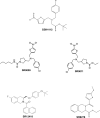The role of REV-ERB in NASH
- PMID: 35217816
- PMCID: PMC9061770
- DOI: 10.1038/s41401-022-00883-w
The role of REV-ERB in NASH
Abstract
REV-ERBs are atypical nuclear receptors as they function as ligand-regulated transcriptional repressors. The natural ligand for the REV-ERBs (REV-ERBα and REV-ERBβ) is heme, and heme-binding results in recruitment of transcriptional corepressor proteins such as N-CoR that mediates repression of REV-ERB target genes. These two receptors regulate a large range of physiological processes including several important in the pathophysiology of non-alcoholic steatohepatitis (NASH). These include carbohydrate and lipid metabolism as well as inflammatory pathways. A number of synthetic REV-ERB agonists have been developed as chemical tools and they show efficacy in animal models of NASH. Here, we will review the functions of REV-ERB with regard to their relevance to NASH as well as the potential to target REV-ERB for treatment of this disease.
Keywords: Heme; NASH; REV-ERB; circadian clock; inflammation; lipid and glucose metabolism.
© 2022. The Author(s), under exclusive licence to Shanghai Institute of Materia Medica, Chinese Academy of Sciences and Chinese Pharmacological Society.
Conflict of interest statement
The authors declare no competing interests.
Figures


References
-
- Pourcet B, Zecchin M, Ferri L, Beauchamp J, Sitaula S, Billon C, et al. Nuclear receptor subfamily 1 group D member 1 regulates circadian activity of NLRP3 inflammasome to reduce the severity of fulminant hepatitis in mice. Gastroenterology. 2018;154:1449–64. doi: 10.1053/j.gastro.2017.12.019. - DOI - PMC - PubMed
MeSH terms
Substances
Grants and funding
LinkOut - more resources
Full Text Sources
Medical
Research Materials

